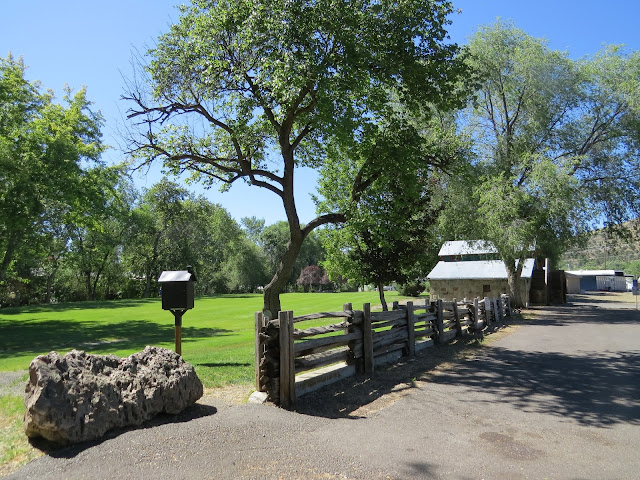This historical site is located in the town of John Day along the Journey Through Time Scenic Byway, US 26 in Oregon.
When two Chinese men went into partnership and bought this building in the late 1880s, John Day's Chinatown was the second largest in Oregon, second only to Portland.
Thousands of desperate Chinese men left war-torn China seeking work in America. They were hired as cheap labor in the mines and building railroads, doing work that many Americans didn't want to do. Only men came; they were not allowed to bring their families.
But they became resented by the Americans who claimed they took away American jobs....sound familiar? I find it interesting that it was a Democratic President who promoted a bill to stop Chinese immigration.
It was about this time that the business partnership of Ing Hay, herbalist, and Lung On, businessman, established Kam Wah Chung & Co. The words mean "Golden Flower of Prosperity."
It became a safe haven in a sea of hostility. A place of worship, a place to buy anything they needed, especially Chinese products, a place where they could find a warm meal and a bed when needed.
Lung On wrote and read letters to help the Chinese keep in touch with their loved ones in China. Doc Hay cured their ills with familiar Eastern Remedies.
In fact, Doc Hay became so successful in diagnosing and curing ailments, that he drew the attention of the other townspeople who began to come to him for treatment too.
When Doc Hay died, the building was closed up and forgotten for many years. Everything inside was just as he left it. That is what is unique about this guided tour.
The door was barricaded at night, when carousing cowboys were most apt to shoot at it. There are two bullet holes visible in the door.
Everything is as Doc Hay left it in 1952 when he fell and broke his hip. He expected to return, but died a month later in a Portland hospital. Lung On had died in 1940.
The apothecary shop still has boxes of Chinese herbal medicines and animal parts that were used in his cures.
Bear paw and other animal parts.
This is the bedroom where Doc hay slept for more than 50 years. In the trunk under the bed was discovered over $23,000 in uncashed checks from his patients. They are on display in the interpretive center.
We were told those are rattlesnakes in that bottle.
The box that is partially pulled out above the bottle is labeled, "dragon" bones. It has been determined to contain fossilized dinosaur bones.
This part of the room was Lung On's mercantile. It appears that tobacco and liquor were popular items.
There are several altars in the building with sticks of incense. The citrus fruit you see is the original from 1950s...it has dried in the cold dark environment it was left in for years.
I can't remember the name of the violin type instrument hanging on the wall. The building became the social center for the community and men would gather to play cards or gamble and other social activities. Do you see the key for winding the clock?
This large altar was the public altar.
No one knows why there are two calendars on the wall dated November 1920.
The kitchen where meals were prepared for boarding house guests.
Another altar in the kitchen.
Hand-made utensils.
These were the platform beds for boarding house guests. Advertisements were pasted on the walls and ceiling. The ones on the ceiling were pasted in two directions, indicating that 2 guests laid with heads in opposite directions.
This was Lung On's bedroom. The furniture and his belongings had all been removed as was Chinese custom after a death.
The square on the floor is a chopping block that goes all the way to the ground, so that wood could be chopped in the kitchen.
Kam Wah Chung is the only remaining building from what was Chinatown in John Day. It was fated to be torn down too until city officials went inside and discovered the cultural treasure inside. The area around the building is now a public park.
Here are a few more pictures from the town of John Day.
An old 7th-Day Adventist Church:
Main Street
Some murals beside the community coffee house.
A map of the county showing towns and points of interest.
I didn't stop at the Dirty Shame Saloon.
Scenery between John Day and Prairie City.
Journey Through Time Scenic Byway....more to come.







































